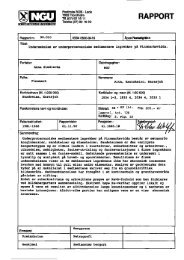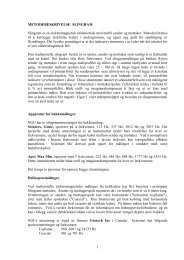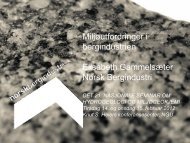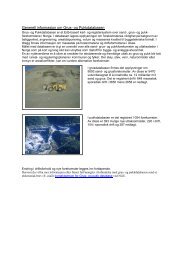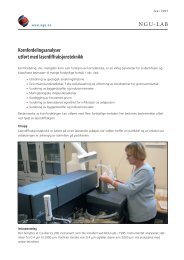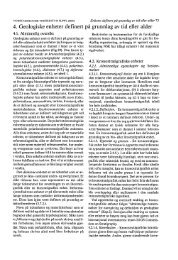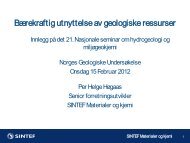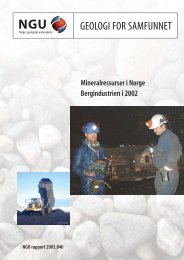Granåsen, a dolomite-brucite deposit with potential for ... - NGU
Granåsen, a dolomite-brucite deposit with potential for ... - NGU
Granåsen, a dolomite-brucite deposit with potential for ... - NGU
You also want an ePaper? Increase the reach of your titles
YUMPU automatically turns print PDFs into web optimized ePapers that Google loves.
<strong>NGU</strong>-BULL 436, 2000 - PAGE 75<br />
<strong>Granåsen</strong>, a <strong>dolomite</strong>-<strong>brucite</strong> <strong>deposit</strong> <strong>with</strong> <strong>potential</strong> <strong>for</strong><br />
industrial development<br />
ODD ØVERENG<br />
Øvereng, O. 2000: <strong>Granåsen</strong>, a <strong>dolomite</strong>-<strong>brucite</strong> <strong>deposit</strong> <strong>with</strong> <strong>potential</strong> <strong>for</strong> industrial development. Norges geologiske<br />
undersøkelse Bulletin 436, 75-84.<br />
<strong>Granåsen</strong>, situated close to Mosjøen in northern Norway, is a <strong>deposit</strong> containing several million tonnes of <strong>dolomite</strong><br />
and <strong>brucite</strong>. The <strong>deposit</strong> has been investigated and characterised in preparation <strong>for</strong> future development and<br />
exploitation. The ore consists of <strong>dolomite</strong> and <strong>brucite</strong>. Brucite has <strong>for</strong>med as a result of hydrothermal alteration<br />
associated <strong>with</strong> intrusion of gabbro. Tests have been carried out to evaluate the commercial value of the <strong>dolomite</strong><br />
resources. A variety of different beneficiation methods were investigated to achieve commercial concentrates of<br />
<strong>brucite</strong>. The most successful result was obtained by selective flocculation, which up-grades the ore to a maximum<br />
grade of 95.5 % <strong>brucite</strong>, <strong>with</strong> a recovery of 80 %. As an alternative, or by-product of <strong>brucite</strong> concentrate production,<br />
the <strong>deposit</strong> could also be worked <strong>for</strong> <strong>dolomite</strong>.<br />
Odd Øvereng, Norges geologiske undersøkelse, N-7491 Trondheim, Norway.<br />
Introduction<br />
Since the beginning of the 1970s, the Geological Survey of<br />
Norway (<strong>NGU</strong>) has investigated a large number of industrial<br />
mineral occurrences. In the early stage of this programme, a<br />
large <strong>deposit</strong> of high-quality <strong>dolomite</strong> marble was found<br />
some 13 km north of the town Mosjøen, in Nordland county<br />
(Fig. 1). The <strong>deposit</strong> has a favourable location, as it is situated<br />
only 3 km from Vefsnfjord, <strong>with</strong> railway and good harbour<br />
facilities, and is close to a well-developed infrastructure at<br />
Mosjøen. The location is also favourable from an environmental<br />
point of view. This paper reviews the exploration history<br />
of the <strong>Granåsen</strong> <strong>dolomite</strong>-<strong>brucite</strong> <strong>deposit</strong>.<br />
History of investigations<br />
The <strong>Granåsen</strong> <strong>dolomite</strong> marble <strong>deposit</strong> was first described by<br />
Øvereng (1972). Since then, much work has been carried out<br />
<strong>with</strong> the primary goal of obtaining reliable in<strong>for</strong>mation about<br />
the size, geometry and quality of the <strong>deposit</strong>. In 1974, the<br />
central part was mapped at a scale of 1:5,000, and several<br />
short drillholes were financed by Norcem A/S to test the quality<br />
of the ore (Øvereng 1974). Norcem A/S signed royalty<br />
agreements <strong>with</strong> the landowners.<br />
In 1975 a co-operative project between <strong>NGU</strong> and SINTEF<br />
was initiated to evaluate technical aspects <strong>for</strong> use of Norwegian<br />
<strong>dolomite</strong> marble in production of basic refractory products.<br />
Dolomite marbles from a number of localities were<br />
tested <strong>for</strong> this purpose (Seltveit et al. 1977). The <strong>dolomite</strong><br />
from <strong>Granåsen</strong> gave excellent results. Material was also sent<br />
to Dolomitwerke GmbH, Wülfrath, Germany, one of the leading<br />
producers of refractory bricks. The tests gave results comparable<br />
to those obtained at SINTEF and encouraged <strong>NGU</strong> to<br />
continue core drilling at <strong>Granåsen</strong> in 1978. Additional testing<br />
of these cores confirmed the earlier results (Øvereng 1978). In<br />
1979, the mineral <strong>brucite</strong> (Mg(OH) 2) was discovered in parts<br />
of the <strong>Granåsen</strong> <strong>dolomite</strong> marble (Faye & Øvereng 1979).<br />
Extensive mineralogical and geological investigations,<br />
including diamond drilling, were carried out in 1979 and<br />
1980 (Øvereng 1981), and confirmed the interpretation that<br />
the <strong>brucite</strong> mineralisation is related to the contact-metamorphic<br />
effects of the Mosjøen gabbro. During this programme,<br />
a variety of different tests were carried out to estimate the<br />
likely commercial value of the <strong>deposit</strong> (Øvereng 1995). Similar<br />
<strong>brucite</strong>-<strong>dolomite</strong> <strong>deposit</strong>s are described from Canada, e.g.<br />
by Goudge (1957) and Ambrose (1943), and from the USA<br />
(Burnham 1959).<br />
Brucite is an industrial mineral <strong>with</strong> a far higher content of<br />
MgO (69.1 wt. %) or elemental Mg (41.6 wt. %) than any other<br />
naturally occurring magnesium compound, except the<br />
rather rare mineral periclase (MgO). In comparison, the main<br />
currently exploited sources of Mg-compounds, magnesite,<br />
magnesium chloride and <strong>dolomite</strong>, contain 28.8, 25.5 and<br />
12.6 wt. % Mg, respectively. Brucite is there<strong>for</strong>e a mineral of<br />
considerable interest as an alternative raw material <strong>for</strong> production<br />
of MgO and elemental Mg.<br />
Geological setting<br />
The <strong>Granåsen</strong> area is located in the Elsfjord–Mosjøen tectonostratigraphic<br />
unit (Riis & Ramberg 1979) in the Helgeland<br />
region of Nordland. The rocks of the area belong to the eastern<br />
part of the Helgeland Nappe Complex (HNC), the uppermost<br />
unit of a series of nappes in the Central Scandinavian<br />
Caledonides and ascribed to the Uppermost Allochthon (Gee<br />
& Zachrisson 1979). The Uppermost Allochthon in this region<br />
consists of three tectonic complexes, the HNC, the Beiarn<br />
Nappe and the Rödingfjället Nappe Complex. These complexes<br />
broadly consist of comparable lithologies: mica<br />
schists, calcareous mica schists, marbles, amphibolites, serpentinites,<br />
gneisses and granitoid intrusions (Gavelin & Kulling<br />
1955, Ramberg 1965, 1967, Gustavson 1981).
<strong>NGU</strong>-BULL 436, 2000 - PAGE 76 ODD ØVERENG<br />
Fig. 1. Geological map of the <strong>Granåsen</strong> <strong>dolomite</strong> <strong>deposit</strong> (Øvereng 1981).
ODD ØVERENG<br />
Fig. 2. Geological profiles from the <strong>Granåsen</strong><br />
<strong>dolomite</strong> <strong>deposit</strong> (Øvereng 1981).<br />
Traditionally, the Uppermost Allochthon had been considered<br />
as essentially comprising Cambro-Silurian rocks,<br />
de<strong>for</strong>med and metamorphosed during Caledonian mountain<br />
building (e.g., Strand 1960). No fossils have yet been<br />
found in sedimentary rocks from the Uppermost Allochthon,<br />
but radiometric ages indicate that parts of the gneissic units<br />
are of Precambrian age. Intrusive rocks, however, are of both<br />
Late Precambrian and Cambro-Silurian to Late Silurian age<br />
(Priem et al. 1975, Claesson 1979). Rock units in the area are<br />
strongly de<strong>for</strong>med and the observed mineral assemblages<br />
<strong>NGU</strong>-BULL 436, 2000 - PAGE 77<br />
are the result of the major phase of de<strong>for</strong>mation, metamorphism<br />
and nappe translation that took place during the Scandian<br />
phase of the Caledonian Orogeny in Late Silurian to<br />
Early Devonian time. In contrast to other nappes in the<br />
Uppermost Allochthon, the HNC hosts sizeable bodies of synorogenic<br />
intrusions which crop out over more than 30 % of<br />
the area. In accordance <strong>with</strong> the regional trend, the rock units<br />
in the <strong>Granåsen</strong> area have a complex and prolonged de<strong>for</strong>mation<br />
history (Riis & Ramberg 1979). In the HNC, early folds<br />
have N-S axes and almost upright axial planes. Gabrielsen &
<strong>NGU</strong>-BULL 436, 2000 - PAGE 78 ODD ØVERENG<br />
Ramberg (1979) suggested two phases of thrusting <strong>for</strong> the<br />
HNC, both older than the latest folding phases in the area.<br />
Metamorphism in the Mosjøen unit of the HNC is apparently<br />
linked to the second, main de<strong>for</strong>mation phase (D 2), which<br />
overprints older magmatic mineral assemblages. The P-T<br />
conditions of metamorphism are assumed to be about 500 –<br />
600 o C, at 2.0 – 3.5 kb, <strong>with</strong> increasing temperatures towards<br />
the contact <strong>with</strong> the Mosjøen Igneous Complex (Theisen<br />
Juell 1985).<br />
The <strong>Granåsen</strong> <strong>dolomite</strong>-<strong>brucite</strong><br />
<strong>deposit</strong><br />
The lens-shaped <strong>deposit</strong>, which crops out between 115 and<br />
180 m above sea level, is 1200 m in length <strong>with</strong> a maximum<br />
width of 900 m. In total, it covers an area of about 1.3 km 2 ,<br />
<strong>with</strong> a thickness of more than 400 m, as proven by core drilling.<br />
The area has been mapped at the scale of 1:5,000 (Fig.1).<br />
The central part of the <strong>deposit</strong> is a flat-lying swampy area.<br />
Core drilling indicates that the thickness of the overburden<br />
varies from 1 to 3 m.<br />
The <strong>deposit</strong> is built up of a sedimentary sequence (Fig. 2)<br />
consisting of <strong>dolomite</strong> marble, underlain by a grey, impure<br />
calcite marble that gradually, <strong>with</strong> an increasing content of<br />
silicates, grades into calcite-mica schist and mica schist.<br />
Locally, the mica schist is mixed <strong>with</strong> thin bands of quartzite/<br />
quartz schist. Assuming that the succession of sedimentary<br />
rocks is not inverted, the <strong>dolomite</strong> marble is the youngest<br />
unit in the sequence. The contact between the <strong>dolomite</strong> marble<br />
and the underlying calcite marble is sharp and concordant.<br />
The metasedimentary units are strongly folded, and now<br />
dip steeply to the west at about 70 o . The major fold axis<br />
strikes NNW-SSE, parallel to the regional strike, <strong>with</strong> a SW<br />
plunge.<br />
The Mosjoen Gabbro Massif intrudes the metasedimentary<br />
strata. The contact between the gabbro massif and the<br />
metasedimentary rocks is very irregular and sharp, and<br />
mostly concordant. There are numerous apophyses of gabbroic<br />
material in the <strong>for</strong>m of dykes, sills and irregular masses<br />
<strong>with</strong>in the surrounding strata. Some of these occur at a considerable<br />
distance from the main contact. Isolated, irregular<br />
bodies of gabbro distributed <strong>with</strong>in the sequence are considered<br />
to be stringer intrusions from the gabbro massif. The<br />
youngest geological event in the <strong>deposit</strong> is recorded by a<br />
series of minor lenses of cross-cutting pegmatites of granitic<br />
to granodioritc composition. Geophysical investigations<br />
(Eidsvik 1979, Dalsegg 1981) and exploratory core drillings<br />
indicate that the gabbro underlies a greater part of the sedimentary<br />
sequence.<br />
Along the main contact <strong>with</strong> the gabbro massif, and<br />
around minor bodies of gabbro <strong>with</strong>in the <strong>deposit</strong>, the <strong>dolomite</strong><br />
marble has been contact metamorphosed, and <strong>brucite</strong>,<br />
Mg(OH) 2 , is one of the final products. Brucite mineralisation<br />
occurs exclusively in the <strong>dolomite</strong> marble adjacent to the<br />
gabbro and has not been found in the contact zone around<br />
granite-granodiorite pegmatite bodies. The average thickness<br />
of the mineralised zone along the main contact is estimated<br />
to be about 40 m over a length of 800 m. The <strong>brucite</strong><br />
content is, on average, about 17 wt. %; individual samples<br />
may contain up to 23 wt. % <strong>brucite</strong>.<br />
Exploratory core drilling in the <strong>deposit</strong> (5000 m of core)<br />
revealed that <strong>brucite</strong> occurs in distinct layers <strong>with</strong>in the <strong>dolomite</strong><br />
marble. Distribution of <strong>brucite</strong> <strong>with</strong>in the layers<br />
appears to be concentrated in a very complex network of<br />
veinlets, <strong>with</strong> a gradual decrease in <strong>brucite</strong> concentration<br />
away from the gabbro contact. Layers of <strong>brucite</strong>-bearing <strong>dolomite</strong><br />
alternate <strong>with</strong> layers of pure <strong>dolomite</strong> or <strong>dolomite</strong> <strong>with</strong><br />
granules of olivine (<strong>for</strong>sterite), or of olivine displaying varying<br />
grades of alteration to serpentine and <strong>brucite</strong>. Since <strong>brucite</strong><br />
is more soluble than carbonates, the <strong>brucite</strong> content can be<br />
roughly estimated from the naturally-etched weathering surfaces.<br />
There is always some olivine and/or serpentine in the<br />
<strong>brucite</strong>-bearing layers, but only a minor amount of <strong>brucite</strong> in<br />
the olivine/serpentine-rich layers. The <strong>brucite</strong>-rich layers are<br />
spaced at intervals from a few cm up to ca. 20 m. Field observations,<br />
together <strong>with</strong> examination of drillcore, suggest that<br />
the layers enriched in <strong>brucite</strong> are not always concordant <strong>with</strong><br />
the primary bedding in the <strong>dolomite</strong> marble.<br />
Mineralogy<br />
The <strong>dolomite</strong> marbles are mostly granular, and vary from fineto<br />
coarse-grained (0.1-1.5 mm, mean 0.6 mm), reflecting the<br />
grade of the metamorphism. Most of the <strong>dolomite</strong> marbles<br />
are white, but in certain parts of the <strong>deposit</strong> the colour is pale<br />
bluish-grey, due to minor amounts of finely dispersed graphite.<br />
The most important impurities are calcite, <strong>for</strong>sterite, serpentine,<br />
mica and tremolite (Table 1). Tremolite, as irregular<br />
masses or disseminated grains, only occurs in specific layers<br />
in the <strong>dolomite</strong> marble, but is practically absent in the <strong>brucite</strong>-rich<br />
zones. Most common accessories are quartz, feldspar,<br />
mica, graphite, diopside, zircon, rutile, apatite, titanite<br />
and various oxides and sulphides.<br />
Based on the observations from mapping, diamond drilling<br />
and geophysics, the most promising area <strong>for</strong> quarrying<br />
pure <strong>dolomite</strong> marble would be in the central part of the<br />
<strong>deposit</strong> (Tables 2 & 3). Geochemical investigations have also<br />
been carried out in this part of the <strong>deposit</strong>.<br />
The occurrence of <strong>brucite</strong> in marble is quite common<br />
(Table 4). The classical mechanism <strong>for</strong> <strong>brucite</strong> <strong>for</strong>mation is as<br />
follows: when <strong>dolomite</strong> marble or Mg-bearing limestone is<br />
exposed to contact metamorphism, the mineral periclase<br />
(MgO) is <strong>for</strong>med and immediately hydrates to <strong>brucite</strong> in the<br />
presence of water (Turner 1954):<br />
CaMg(CO3) 2 —> CaCO3 + MgO + CO2 <strong>dolomite</strong> calcite periclase<br />
MgO + H2O —> Mg(OH) 2<br />
periclase <strong>brucite</strong><br />
The final products of the carbonate rocks after contact<br />
metamorphism depend on a number of factors. The most<br />
important are the chemical composition and mineralogy of<br />
the sedimentary sequence and the temperature and pressure<br />
prevailing at the time of intrusion.<br />
(1)<br />
(2)
ODD ØVERENG<br />
Table 1. Modal analyses of pure <strong>dolomite</strong> marble. Drillcore samples are representative of the central part of the <strong>deposit</strong>.<br />
Mineral / sample 2-79/1 2-79/3 2-79/14 2-79/19 2-79/22 2-79/24 2-79/26<br />
Brucite * * * * * * *<br />
Dolomite 95.0 95.4 96.9 98.8 99.0 95.5 95.6<br />
Calcite 3.5 3.1 2.1 * 0.6 3.7 1.3<br />
Olivine/Serpentine 1.4 1.0 0.5 0.3 nd nd nd<br />
Other minerals 0.1 0.5 0.5 1.8 0.4 0.8 3.1<br />
* not measured<br />
nd not detected<br />
<strong>NGU</strong>-BULL 436, 2000 - PAGE 79<br />
Table 2. Major element analyses (XRF) of pure <strong>dolomite</strong> marble in wt. %. The samples are collected from 6 drillholes in the central part of the<br />
<strong>deposit</strong>. Each sample represents a core length of 30 m. Measurements by Philips PW1480 X-ray fluorescence spectrometer on glass discs<br />
made by fusing the sample and Li 2 B 4 O 7 in the ratio 1:7 (analyst: B.Nilsen).<br />
Oxide / Sample Bh.1/77 Bh.2/77 Bh.3/77 Bh.4/77 Bh.5/77 Bh.6/77<br />
SiO2 7.19
<strong>NGU</strong>-BULL 436, 2000 - PAGE 80 ODD ØVERENG<br />
In the <strong>Granåsen</strong> area, <strong>brucite</strong> mineralisation occurs exclusively<br />
in the <strong>dolomite</strong> marble adjacent to gabbro. This suggests<br />
that the <strong>brucite</strong> is genetically related to the intruding<br />
gabbro, and that the intrusion supplied the heat necessary to<br />
<strong>for</strong>m hydrothermal solutions which decomposed <strong>dolomite</strong><br />
to <strong>for</strong>m <strong>brucite</strong> and accompanying minerals. The major <strong>brucite</strong><br />
mineralisation in <strong>Granåsen</strong> area occurs along the main<br />
contact <strong>with</strong> the gabbro massif, which indicates a direct correlation<br />
between the size of intrusion and the degree of <strong>dolomite</strong><br />
breakdown into <strong>brucite</strong> and calcite. Brucite content<br />
typically decreases away from the contact.<br />
In individual samples of <strong>brucite</strong>-bearing <strong>dolomite</strong> marble,<br />
the <strong>dolomite</strong>/calcite ratio is widely variable, depending on<br />
the intensity of the alteration of <strong>dolomite</strong> to <strong>brucite</strong>, calcite<br />
and other minerals. The calculated <strong>dolomite</strong>/calcite ratio in<br />
the area of <strong>brucite</strong>-bearing <strong>dolomite</strong> varies <strong>with</strong>in a wide<br />
interval (0.8-1.3), but the molecular ratio MgO/CaO <strong>for</strong> <strong>dolomite</strong><br />
marble <strong>with</strong> or <strong>with</strong>out <strong>brucite</strong> only varies <strong>with</strong>in a narrow<br />
range (0.62 – 0.68) and is close to that of pure <strong>dolomite</strong><br />
(0.72). These results indicate that the original strata at the<br />
border were pure <strong>dolomite</strong> marbles prior to the intrusion of<br />
gabbro.<br />
Most of the <strong>brucite</strong> in the <strong>Granåsen</strong> area occurs as irregular<br />
and rounded grains ranging in size from < 0.01 mm up to<br />
1 mm; on average, around 0.35 mm. The granules appear<br />
milky-white in colour in a fresh hand specimen and colourless<br />
or faintly brown under the microscope. This granular <strong>brucite</strong><br />
texture occurs in <strong>dolomite</strong>, calcite and olivine/serpentine<br />
assemblages. Differences in the shape of <strong>brucite</strong> granules are<br />
noted to depend on the dominant mineralogy of the matrix,<br />
calcite or <strong>dolomite</strong>. Generally, rounded <strong>brucite</strong> grains occur<br />
<strong>with</strong>in calcite, whereas <strong>brucite</strong> <strong>with</strong>in <strong>dolomite</strong> shows angular<br />
grain boundaries, which in many cases con<strong>for</strong>m to the carbonate<br />
cleavage. Projecting tongues or veinlets of <strong>brucite</strong> in<br />
some cases extend from both angular and rounded <strong>brucite</strong><br />
granules into the surrounding carbonates, along cleavages<br />
or grain boundaries. Some of the <strong>brucite</strong> grains have the<br />
well-known, concentric, onion-skin texture (Hunt & Faust<br />
1937), <strong>with</strong> flakes or fibres in differing orientations in each<br />
successive layer. In plane-polarised light the grains appear<br />
colourless; the complex foliated texture is optimally revealed<br />
under crossed nicols (Fig. 3). Veins of <strong>brucite</strong> are rare, though<br />
they are occasionally seen in drill cores and are composed of<br />
pale green, translucent, flaky <strong>brucite</strong> <strong>with</strong> a pearly lustre.<br />
Other minerals are calcite and minor amounts of quartz, feldspar,<br />
spinel, epidote, titanite, apatite, actinolite, <strong>for</strong>sterite and<br />
diopside. In addition, opaque minerals such as pyrite and<br />
hematite are sporadically present.<br />
In the <strong>Granåsen</strong> area, some of the <strong>brucite</strong> grains occur as<br />
alteration products of <strong>for</strong>sterite. The distribution and general<br />
appearance of the <strong>for</strong>sterite, which is distributed throughout<br />
the <strong>dolomite</strong> and calcite as round small grains 0.01–0.5 mm<br />
in size, is similar in many respects to those of the granular<br />
<strong>brucite</strong>. There are many examples of progressive replacement<br />
of <strong>for</strong>sterite by <strong>brucite</strong>. In many thin-sections, polycrystalline<br />
aggregates of <strong>brucite</strong> have replaced whole grains of<br />
<strong>for</strong>sterite, retaining the original crystal shape. Forsterite has<br />
also in varying degrees altered to chrysotile. Brucite may, in<br />
Fig. 3. Flow sheet <strong>for</strong> selective calcination and leaching (Jepsen 1981).<br />
such cases, occur as extremely fine-grained intergrowths<br />
<strong>with</strong> chrysotile. In spite of careful examination of thin-sections<br />
from a large number of representative specimens, no<br />
periclase has been found. At <strong>Granåsen</strong>, spinel occurring as<br />
cores in <strong>brucite</strong> has been proven by electron microprobe<br />
examination. Table 5 shows the chemical composition of<br />
brucitic <strong>dolomite</strong> marble from different places along the<br />
main contact of the gabbro massif. Table 6 shows element<br />
compositions of <strong>brucite</strong>, <strong>dolomite</strong>, calcite and <strong>for</strong>sterite from<br />
different places along the contact zone. One of the holes<br />
drilled in the contact zone has a particularly high <strong>brucite</strong> content,<br />
varying from 20 to 30 wt. %, over a thickness of about<br />
120 m.<br />
Mineral resource assessment<br />
Based on existing drillcore intersections and geological mapping,<br />
the available tonnage of pure <strong>dolomite</strong> marble down to<br />
sea level is estimated to be between 80 and 100 M tonnes.<br />
The tonnage estimation of the <strong>brucite</strong> ore, however, is less<br />
certain. A tentative estimate in two restricted areas (Finnhaugen,<br />
Stuvremma) in the main contact zone to the gabbro, 1<br />
km in length and 40 metres in thickness and <strong>with</strong> an indicated<br />
average of 17 wt. % <strong>brucite</strong>, gave the following results:<br />
(Ryssdal 1984)<br />
Total volume: 3.2 M m 3<br />
Total rock tonnage (S.G = 2.7): 8.64 M tonnes<br />
Total tonnage of <strong>brucite</strong> (17 wt. %): 1.50 M tonnes<br />
Recoverable <strong>brucite</strong> (assuming 80 %<br />
recovery): 1.2 M tonnes<br />
Diamond drilling shows that <strong>brucite</strong> mineralisation of<br />
<strong>potential</strong> economic value occurs not only in the border zone<br />
along the main contact, but also in the contact zone around
ODD ØVERENG<br />
the largest bodies of gabbro <strong>with</strong>in the <strong>dolomite</strong> marble.<br />
Because of the complexity of the mineralisation it is necessary<br />
to undertake extensive additional diamond drilling to<br />
obtain sufficient data to provide a reliable tonnage estimate<br />
<strong>for</strong> the <strong>brucite</strong> ore.<br />
Brucite concentration<br />
The <strong>brucite</strong> ores are relatively fine-grained and require milling<br />
to 30-40 % minus 40-150 µm, to obtain 80-90 % total liberation<br />
of <strong>brucite</strong>. Crushing and milling tests show that the<br />
<strong>brucite</strong> ore did not fit into existing liberation models because<br />
of the different milling properties of <strong>brucite</strong> versus the carbonate<br />
minerals. The dominant liberation mechanism is liberation<br />
of single grains along the contact. A characteristic of<br />
the milling products is the high content of <strong>brucite</strong> in the<br />
coarse fraction and in the 40-150 µm fraction. Brucite has a<br />
layered crystal structure, which manifests itself as a micaceous<br />
foliation and a perfect basal cleavage. Thus, crushing,<br />
impact or vigorous attrition of individual <strong>brucite</strong> grains<br />
should be avoided in the process. Otherwise, the <strong>brucite</strong> may<br />
cleave into thin plates which would be difficult to separate in<br />
a sizing apparatus. The tests carried out at NTNU, Trondheim,<br />
<strong>NGU</strong>-BULL 436, 2000 - PAGE 81<br />
Table 5. Major element analyses (XRF) of <strong>dolomite</strong> marble <strong>with</strong> different contents of <strong>brucite</strong> in wt. %. Measurements by Philips PW1480 X-ray<br />
fluorescence spectrometer (analyst: B.Nilsen). Brucite content is determined by the Phenfield method (Graff 1983).<br />
Sample SiO 2 Al 2 O 3 Fe 2 O 3 TiO 2 MgO CaO Na 2 O K 2 O MnO P 2 O 5 Brucite<br />
Pr.1 0.28
<strong>NGU</strong>-BULL 436, 2000 - PAGE 82 ODD ØVERENG<br />
Fig. 4. Brucite as a series of concentric swirls of foliated aggregates. The<br />
bluish/black enclosed grains are fragments of unaltered <strong>for</strong>sterite. Photomicrograph<br />
under crossed nicols.<br />
residues containing more than 75 % CaO. The results from<br />
the testing <strong>with</strong> selective calcination and leaching are given<br />
in Table 7 and a flow sheet <strong>for</strong> the process is shown in Fig. 4.<br />
Direct leaching<br />
The Institute <strong>for</strong> silicate and high-temperature chemistry at<br />
NTNU/SINTEF carried out a leaching test on a sample of representative<br />
<strong>brucite</strong> ore. The test procedure was a modified<br />
version of the so-called Sulmag-process and resulted in 150<br />
kg <strong>brucite</strong> per tonne of ore. The raw material had a content of<br />
<strong>brucite</strong> of about 15 wt. % (Monsen & Seltveit 1984).<br />
Gravity separation<br />
Basic Inc. Gabbs, Nevada, USA used a patented sink-float<br />
method <strong>with</strong> heavy liquid media (methylene bromide, 2.48<br />
kg/dm 3 ). The result was a concentrate <strong>with</strong> 93.3 wt. % of <strong>brucite</strong><br />
(Jepsen 1981). Tests carried out at Purdue University,<br />
USA, <strong>with</strong> Wolframat dissolved in water as medium, gave a<br />
concentrate of 85 wt % <strong>brucite</strong> <strong>with</strong> a recovery of about 80 %<br />
(Øvereng 1987a).<br />
Selective flocculation<br />
Brucite is a very brittle mineral and, as a result, it will usually<br />
be enriched in the finer fractions in the crushing and milling<br />
process. Preliminary tests indicated that about 40 % of the<br />
<strong>brucite</strong> of the feed ore goes into the fines (less than 30-50<br />
µm) during the crushing and milling process and cannot be<br />
treated by the traditional separation methods. Brucite ore<br />
from the <strong>Granåsen</strong> <strong>deposit</strong> has been tested by traditional<br />
separation methods <strong>with</strong>out obtaining a satisfactory <strong>brucite</strong><br />
concentrate.<br />
At Purdue University, USA, the late Prof. Kullerud and his<br />
group developed a separation method which is very efficient<br />
<strong>for</strong> finer grain fractions. The group had earlier used this technique<br />
to separate alunite from quartz in alunite ore. Results<br />
show that the technique is very efficient <strong>for</strong> particle size
ODD ØVERENG<br />
Table 8. Physical data of dead-burned samples tested at<br />
Dolomittwerke GmbH, Wülfrath, Germany and SINTEF, Trondheim.<br />
Dolomitwerke SINTEF<br />
Density, g/cm 3 2.86 -<br />
Volume weight, g/cm 3 2.78 2.79 – 2.84<br />
Open porosity, % 2.80 1.24 – 1.90<br />
Total porosity, % 2.80 -<br />
Table 9. Physical data from a calcination / dead-burned test of<br />
samples of pure <strong>dolomite</strong> marble.<br />
not developed<br />
Burned<br />
at<br />
Split<br />
5-10<br />
mm<br />
1650 o C<br />
Briquettes<br />
ø = 50mm<br />
Burned, 2h.<br />
1800 o C<br />
Split<br />
5 - 10 mm<br />
oxidising<br />
atm.<br />
Briquettes<br />
ø = 10<br />
mm<br />
Density, g/cm3 3.43 - - -<br />
Volume weight,<br />
g/cm 3<br />
2.08 2.83 3.05 3.18<br />
Open porosity, % 39.0 15.8 9.2 2.2<br />
Total porosity, % 39.4 17.5 11.1 7.3<br />
Table 10. Volume weight and porosity of <strong>dolomite</strong> marble, sintered<br />
in Ar-atm. at 2000 o C <strong>for</strong> different lengths of time, in minutes<br />
(SINTEF).<br />
Sintered at 2000 o C Volume weight in g/cm 3 Open porosity<br />
30 min. 2.89<br />
2.78<br />
60 min. 3.01<br />
3.05<br />
120 min. 3.01<br />
3.05<br />
180 min. 3.11<br />
3.00<br />
13.6<br />
16.4<br />
10.3<br />
10.7<br />
10.9<br />
9.5<br />
8.2<br />
11.4<br />
Table 11. Representative reflectance values <strong>for</strong> the pure <strong>dolomite</strong><br />
marble.<br />
Filter Collectsample*<br />
R 457 Tappi (Brightness) 92.3<br />
FMX/C Red (Amber) 93.7<br />
FMY/C Green 93.3<br />
FMZ/C Blue 92.3<br />
R 46 1.50<br />
* fractions < 200µm.<br />
<strong>NGU</strong>-BULL 436, 2000 - PAGE 83<br />
each step in the flow sheet could be optimised, the process<br />
could still be improved.<br />
Product development<br />
In 1975, a co-operative ef<strong>for</strong>t between <strong>NGU</strong> and SINTEF was<br />
initiated to evaluate technical aspects <strong>for</strong> the use of Norwegian<br />
<strong>dolomite</strong> marble in the production of basic refractories.<br />
Dolomite marble from a number of localities was tested <strong>for</strong><br />
this purpose. The <strong>dolomite</strong> marble from <strong>Granåsen</strong>, tested at<br />
SINTEF, gave excellent results (Seltveit et al. 1977). Material<br />
from <strong>Granåsen</strong> was also sent to one of the leading producers<br />
of refractory brick, Dolomitwerke GmbH, Wülfrath, Germany.<br />
Results were comparable to those obtained at SINTEF (Table<br />
8). This encouraged an additional core-drilling programme in<br />
1978. Material from the core drilling was tested by SINTEF.<br />
These tests confirmed the previous results (Øvereng 1977,<br />
1978). Results from different tests indicate that the <strong>dolomite</strong><br />
marble is suitable as a raw material <strong>for</strong> the production of<br />
basic refractories (Seltveit et al. 1977).<br />
Melted <strong>dolomite</strong><br />
The interest to use melted <strong>dolomite</strong> marble is growing and different<br />
institutions and companies have tested Norwegian<br />
<strong>dolomite</strong> marble <strong>for</strong> production of melted <strong>dolomite</strong>. Results<br />
from different tests indicate that <strong>dolomite</strong> marble from<br />
<strong>Granåsen</strong> may be of interest <strong>for</strong> the production of melted<br />
<strong>dolomite</strong> (Tables 9, 10).<br />
Filler/ coating<br />
Dolomite marble <strong>for</strong> fillers and coating is a growing market<br />
and high-quality <strong>dolomite</strong> marble from the <strong>Granåsen</strong> <strong>deposit</strong><br />
should be of interest <strong>for</strong> this market. Chemical analysis and<br />
other test data indicate that a significant portion of the <strong>dolomite</strong><br />
marble fulfils criteria <strong>for</strong> the mineral filler industry.<br />
Brightness is an important parameter of filler/coating materials<br />
and average values of a representative sample from the<br />
central part of the <strong>deposit</strong> are given in Table 11.<br />
Conclusions<br />
The <strong>Granåsen</strong> <strong>deposit</strong> contains around 100 M tonnes of<br />
high-quality <strong>dolomite</strong> marble and 10-15 M tonnes of <strong>brucite</strong>bearing<br />
<strong>dolomite</strong> containing around 17 wt. % <strong>brucite</strong>. The<br />
<strong>brucite</strong> mineralisation occurs in the contact aureole to a gabbro<br />
massif and <strong>for</strong>med by contact metamorphism associated<br />
<strong>with</strong> the intrusion. The results from different tests indicate<br />
that the existing mineral resources at the <strong>Granåsen</strong> <strong>deposit</strong><br />
can <strong>potential</strong>ly be used in a large range of products. Pure <strong>dolomite</strong><br />
marble from the <strong>Granåsen</strong> <strong>deposit</strong> seems to be a suitable<br />
raw material <strong>for</strong> the production of magnesium metal,<br />
basic refractories, glass, filler, insulation, various building<br />
materials, mineral wool, special cements, and also in various<br />
applications in agricultural and environmental uses.<br />
A variety of different separation techniques have been<br />
tested <strong>for</strong> the production of <strong>brucite</strong> concentrate. The most<br />
promising methods gave the following results:
<strong>NGU</strong>-BULL 436, 2000 - PAGE 84 ODD ØVERENG<br />
Selective flocculation: <strong>brucite</strong> concentrate (<strong>brucite</strong> 87 wt.<br />
%), recovery 76 %.<br />
Gravity separation: <strong>brucite</strong> concentrate (<strong>brucite</strong> 85 wt.<br />
%), recovery 80 %.<br />
Leaching (Sulmag): <strong>brucite</strong> concentrate: 150 kg/tonne<br />
(raw ore 15 wt. % <strong>brucite</strong>).<br />
Brucite concentrates from <strong>Granåsen</strong> would be especially<br />
suitable <strong>for</strong> the production of high-quality basic refractories,<br />
MgO, Mg-metal and different fillers. The <strong>deposit</strong> of<br />
<strong>Granåsen</strong> is there<strong>for</strong>e a mineral resource <strong>with</strong> great<br />
<strong>potential</strong>. Future investigations of the <strong>deposit</strong> need to be<br />
focused on a total evaluation of its possibilities.<br />
Acknowledgements<br />
The investigation programme has been carried out as a joint project between<br />
Norges geologiske undersøkelse and Vefsn Utbyggingsselskap A/<br />
S, Mosjøen. Selective flocculating tests have been carried out at Purdue<br />
University, Indiana, USA. The author expresses his thanks to the late Prof.<br />
G. Kullerud and his staff who introduced him to that technique. Thanks<br />
are also due to my colleagues, T.A. Karlsen and the late B.A. Sturt <strong>for</strong> their<br />
valuable criticism and advice in a early stage of preparing this manuscript<br />
and to Nigel J. Cook <strong>for</strong> correcting the manuscript and improving<br />
the English language. David Harrison (BGS) and Yryo Pekkola (GSF) are<br />
thanked <strong>for</strong> their helpful reviews.<br />
References<br />
Ambrose, J.W. 1943: Brucitic limestone and hastingsite syenite near<br />
Wakefield, Quebec. Transactions of the Royal Society of Canada: Sec.<br />
IV, Third Series, 9 –22.<br />
Burnham, C.W. 1959: Contact metamorphism of magnesium limestones<br />
at Crestmore, Cali<strong>for</strong>nia. Geological Society of America Bulletin 70,<br />
879-920.<br />
Claesson, S. 1979: Pre-Silurian orogenic de<strong>for</strong>mation in the north-central<br />
Scandinavian Caledonides. Geologiska Föreningens i Stockholm<br />
Förhandlingar. 101, 353-356.<br />
Dalsegg, E. 1981: IP-og magnetiske målinger i <strong>Granåsen</strong> dolomittfelt,<br />
Vefsn, Nordland. Norges geologiske undersøkelse Report 1822, 9 pp. +<br />
appendices.<br />
Dybdahl, B.A. 1980: Orienterende opprednings<strong>for</strong>søk med brucitt fra<br />
<strong>Granåsen</strong> Oppredningslaboratoriet NTH, Report 02/80, 6 pp. + appendices.<br />
Eidsvik, P. 1979: IP-og magnetiske målinger i <strong>Granåsen</strong> dolomittfelt,<br />
Vefsn, Nordland. Norges geologiske undersøkelse Report 1822, 9 pp. +<br />
appendices.<br />
Hunt, W.F. & Faust, G.T. 1937 : Pencatite from the Organ mountains, New<br />
Mexico. American Mineralogist 22, 1151-1160.<br />
Faye, G.Chr. & Øvereng, O. 1979: <strong>Granåsen</strong> dolomittfelt, Vefsn, Nordland<br />
fylke. Funn av brucitt. Norges geologiske undersøkelse Report 1712, 9<br />
pp. + appendices.<br />
Gabrielsen, R H. & Ramberg, I. B. 1979: Skyvesonen mellom Rødingsfjelldekket<br />
og Helgelandsdekket i området Tustervatn, Helgeland.<br />
Geologinytt 13, 22-23.<br />
Gavelin, S. & Kulling, O., 1955: Beskrivning till berggrundskarta över Västerbottens<br />
Län. Sveriges geologiska undersökelse, Ser., Ca 37, 5-99.<br />
Gee, D. G. & Zachrisson, E. 1979: The Caledonides in Sweden. Sveriges<br />
geologiska undersøkelse, C769, 1-48.<br />
Goudge, M. F. 1957: Brucite. The geology of Canadian Industrial Mineral<br />
Deposits. 6 th Commonwealth Mining and Metallurgy Congress, Canadian<br />
Institute of Mining and Metallurgy, Industrial Minerals Division,<br />
Winnipeg 1957, 61-69.<br />
Graff, P. R. 1983: Bestemmelse av brucitt i karbonatbergarter. Norges<br />
geologiske undersøkelse 388, 13-15.<br />
Gustavson, M. 1981. Geologisk kart over Norge, bergrunnskart Mosjøen<br />
1: 250.000. Norges geologiske undersøkelse.<br />
Jepsen, T.L.B. 1981: Brucitic Dolomite- Granaasen Orebody. Consultancy<br />
report <strong>for</strong> Vefsn Utbyggingsselskap A/S. (also as an appendix in <strong>NGU</strong><br />
report 1780; Øvereng 1981).<br />
Malvik, T. 1980: Undersøkelse av frimalingsegenskapene til brucitt fra<br />
<strong>Granåsen</strong>. Unpubl. consultancy report, Geologisk institutt NTH, 8pp. +<br />
appendices, (also as an appendix in <strong>NGU</strong> report 1780; Øvereng<br />
1981).<br />
Malvik, T. 1982: <strong>Granåsen</strong>, brucitt-mineralisert dolomitt-bergart. Male<strong>for</strong>søk.<br />
Unpubl. Consultancy report. Geologisk institutt NTH.<br />
Monsen, B. & Seltveit, A. 1984: Innledende <strong>for</strong>søk med utluting av brucitt<br />
fra "<strong>Granåsen</strong> dolomitt". Unpubl. SINTEF report, prosjekt nr. 341356.<br />
Priem, H.N.A., Boelrijk, N.A.I.M., Hebeda, E.H., Verdurmen, E.A.T. & Verschure,<br />
R.M. 1975: Isotopic dating of Caledonian Bindal and Svenningdal<br />
Granite Massifs, Central Norway. Norges geologiske undersøkelse<br />
319, 29-36.<br />
Ramberg; I. B. 1965: Regional-geologiske undersøkelser i Røssvatnområdet,<br />
sydlige Nordland (Abstract). Geologi (Helsinki) 17, 141.<br />
Ramberg; I. B. 1967: Kongsfjell-områdets geologi, en petrografisk og<br />
strukturell undersøkelse i Helgeland, Nord-Norge. Norges geologiske<br />
undersøkelse 240. 125pp.<br />
Ryssdal, K. 1984: Diamantboring i <strong>Granåsen</strong>. Resultater. Unpubl. Report,<br />
Vefsn Utbyggingsselskap A/S.<br />
Riis, R.A. & Ramberg, I. B. 1979: Nyere data fra Nordlands høymetamorfe<br />
dekkekompleks. Geologinytt 13, 60-61.<br />
Seltveit, A., Steinmo, M. & Viken, K. 1977: Ildfaste dolomittmaterialer<br />
(testing av nordnorske dolomitter). SINTEF-rapport nr. STF34.A77049.<br />
(Rapport <strong>for</strong> NTNF, kjemisk komite).<br />
Seltveit, A. & Viken, K. 1977: Ildfaste dolomittmaterialer (testing av nordnorske<br />
dolomitter). SINTEF-rapport nr. STF34.A79049. (Sluttrapport<br />
<strong>for</strong> NTNF, kjemisk komite).<br />
Strand, T. 1960: The pre-Devonian rocks and structures in the region of<br />
Caledonian De<strong>for</strong>mation. In: Holtedahl O. et. al. Geology of Norway.<br />
Norges geologiske undersøkelse 208, 170-284.<br />
Theisen Juell, F. 1985: En petrologisk og strukturgeologisk undersøkelse av<br />
Reinfjell-området. Unpublished Thesis, University of Oslo, 279 pp.<br />
Turner, F.J. 1954: Petrology, An Introduction to the Study of Rocks in Thin<br />
Section, W.H. Freeman and Company, San Francisco, 1046 pp.<br />
Øvereng, O. 1972: Råstoffundersøkelser i Nord-Norge. Kalkstein og dolomitt<br />
undersøkelser Nordland fylke, delrapport 1118/9F. Kalkstein og<br />
dolomitt i Vefsn kommune. Norges geologiske undersøkelse Report<br />
1118/9, 53-60 + appendices.<br />
Øvereng, O. 1974: <strong>Granåsen</strong> dolomittfelt, Vefsn, Nordland. Geologi,geologisk<br />
beskrivelse av borkjerner,uttak og analysering av borkjerneprøver.<br />
Norges geologiske undersøkelse Report 1242 C, 7 pp. + appendices.<br />
Øvereng, O. 1977: Råstoffundersøkelser i Nord-Norge. <strong>Granåsen</strong> dolomittfelt,<br />
Vefsn kommune, Nordland. Norges geologiske undersøkelse<br />
Report 1556/4A, 32 pp. + appendices.<br />
Øvereng, O. 1978: Råstoffundersøkelser i Nord-Norge. <strong>Granåsen</strong> dolomittfelt,<br />
Vefsn kommune, Nordland fylke. Norges geologiske undersøkelse<br />
Report 1625/5A, 34 pp. + appendices.<br />
Øvereng, O. 1981: <strong>Granåsen</strong> dolomittfelt, Vefsn, Nordland. Norges geologiske<br />
undersøkelse Report 1780, 38 pp. + appendices.<br />
Øvereng, O. 1987a: <strong>Granåsen</strong>-prosjektet. Fremstilling av brucitt-konsentrater<br />
ved bruk av tunge vesker. Unpublished report <strong>for</strong> Vefsn Utbyggingsselskap<br />
A/S, 45 pp. + appendices.<br />
Øvereng, O. 1987b: <strong>Granåsen</strong>-prosjektet. Utvikling av metode (selektiv<br />
flokulering) <strong>for</strong> fremstilling av brucitt-konsentrater. Unpublished<br />
report <strong>for</strong> Vefsn Utbyggingsselskap A/S, 45pp.<br />
Øvereng, O. 1995: <strong>Granåsen</strong> dolomittfelt, Vefsn kommune, Nordland.<br />
Sluttrapport. Norges geologiske undersøkelse Report 95.025, 34 pp.




